"Films are an art, but they're also an industry. Forget that a moment and you have a money loser on your hands"
- Sir Run Run Shaw, Signature, January 1981
Capturing the imagination of millions, films bearing the "SB" trademark ranged from epic spectaculars to modern drama. Behind this wide variety of product were the immensely talented team from Run Run Shaw’s Studio in Hong Kong who laboured around the clock to manufacture their dreams. Working on a tight budget and tighter deadline, the dedicated production crew had an annual goal of over 40 films. Even with limited time, quality was never sacrificed and this was obvious when the annual international film awards rolled around.
The studio had contracts with the largest roster of stars and directors in the East.
These actors and directors spent most of their careers working within Shaw Studio. Each director had his or her own forte, some excelled in costume epics, others in action or romance. Many of their styles still influence modern chinese films today in the work of their many apprentices. For the various genres, a few directors bear mentioning as the leaders in their field.
Costume masterpieces such as 'The Kingdom and the Beauty', 'Love Eterne' and 'The Empress Dowager' (1975) were the favored subject of Li Han Hsiang, an award winning director of over 40 films for Shaw. In 1963, amidst much controversy, Li left Shaw to form Guolian Film Company in Taiwan. He eventually returned to the Shaw fold by 1972 to make the Michael Hui starrer 'The Warlord'.
Other outstanding directors of the costume epic genre included Griffin Yueh who made Hua Mu-lan' (1963) and Madam Normal Snake' (1963) as well as Cheng Kang of The Twelve Gold Medallions' (1970) and 'The 14 Amazons' (1972) fame.
The Shaw costume films were based on Chinese history as well as folklore. Utilising the vast store of ever popular tales meant that there would be no shortage of ideas. It also eliminated outlays for original screen plays. Although several of these spectaculars boasted casts of 'thousands', budgets of over HK$5 million and actually took months to shoot, what was generally practiced was quite the opposite.
For the average period film, economy was the word. Lavish sets and costumes would be manipulated into endless configurations and filmed from a dozen angles to save cost. Cuts, which were expensive, were avoided in favour of the pan shot.
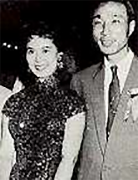
Sir Run Run and Lin Dai
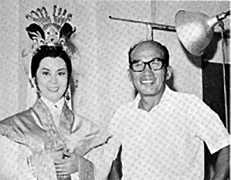
Griffin Yueh with Lin Dai, 1964
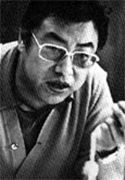
Li Han Hsiang
Not all directors fancied traditional epics, preferring to work at contemporary settings. Directors like Doe Ching found fame in modern romances such as Les Belles (1960), Love Without End (1961) and Blue and Black (1965).
'Blue and the Black' was one of Doe Ching's best work. A contemporary epic which ran four and a half hours in widescreen colour, it had enough spectacle and battle scenes to hold its own against any costume epic. The film won the Asian Film Festival's Best Picture Award and it's star, Lin Dai, won the award for Best Actress.
There were many types of contemporary set films over the years and some of these were made in response to trends set by Hollywood.
In the 1960s, with the popularity of the James Bond films, Shaw's directors began making their own brand of spy movies. Films such as Black Falcon (1966), Sumaru (1966) and Kiss and Kill (1967) catapulted actor Paul Chang Chung into fame as the Hong Kong James Bond. Not forgetting the ladies, The Angel With the Iron Fist (1966) and Special Agent 009 (1967), had Lily Ho and Margeret Tu Chuan playing female Bonds.
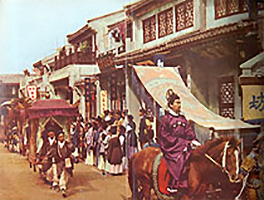
Streets of Chang An, Yang Kwei Fei, 1961
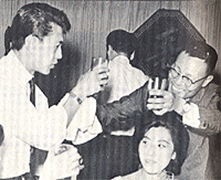
Doe Ching toasts Peter Chen Ho and Fanny Fan 1962
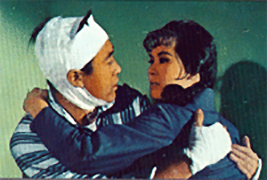
Lin Dai in 'The Blue and the Black' directed by Doe Ching, 1965
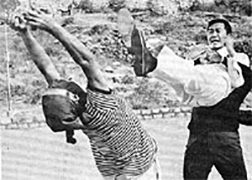
Chang Chung in Black Falcon 1966
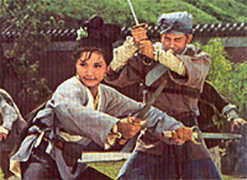
Cheng Pei Pei in Come Drink With Me, 1966
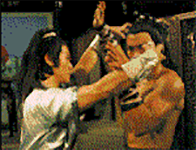
Five Deadly Venoms 1978
Authentic martial arts films had been popular since the post war era when Cantonese films of the legendary pugilist Wong Fei Hong dominated the screens. These films which incorporated righteous values with the art of combat were known as 'Wu Xia Pian' or 'chivalrous combat films'.
In 1966, a Shaw production under martial arts director King Hu was to prove a groundbreaking effort in this genre.
'Come Drink with Me' (1966) starring Cheng Pei Pei utilised inventive techniques and special effects to bring the elegance of martial arts into a new era of realism. This new style 'Wu Xia Pian' was a radical departure from the old in that it depicted gratuitous combat without the trappings of confucian ethics.
Directors like the prolific Chang Cheh brought even more innovations to the world of martial arts films.
His emphasis on using male leads in his films was a radical departure from the then actress dominated Hong Kong film industry.
Among his best films were 'The Magnificent Trio' (1966), The One Armed Swordsman' (1967 - First film to gross HK$1 mil), 'The Assassin' (1967), 'Golden Swallow' (1969), Normal Water Strand' (1970), Vengence!' (1970), 'Duel of Fists' (1971), Boxer From Shantung (1972), 'Blood Brothers' (1973), 'Brave Archer' (1977) and Five Deadly Venoms' (1978) featuring the 'Venom' stars Lu Feng, Kuo Chui, Lo Meng, Chiang Sheng and Sun Chien. These films created a global martial arts frenzy in the 1970s and 80s.
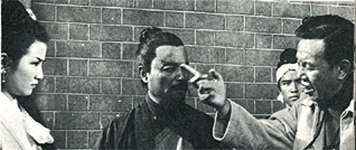
Chang Cheh (right) on the set of Flying Dagger 1968
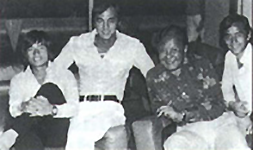
Fu Sheng, Ti Lung, Chang Cheh, David Chiang
With 'Vengence' (1970), Chang Cheh unleashed on the world the cinematic unarmed combat that was to be popularly known as 'kung fu'.
Chang Cheh's influential style of using carefully choreographed slow motion action sequences, his copeous use of blood, strong violence, as well as his recurring 'loyal brotherhood' theme continues today under one of his more famous apprentices, John Woo.
Besides Chang Cheh, arguably the best 'kung fu' director of his time was Liu Kar Leung ('The Spiritual Boxer' (1975), The 36th Chamber of Shaolin (1978) and 8 Diagram Pole Fighter(1983).) One of Liu's forte as a director was because he could identify closely with his actors, having been one himself. Skilled in the martial arts, Liu started his career as an actor playing the legendary martial arts hero Wong Fei Hong (It was said that Liu's grandfather was a disciple of the real Wong Fei Hong).
When he was not in front or behind the camera, Liu would choreograph action sequences for other films. In fact, his choreography in the 1971 Jeng Cheong Woh film 'Five Fingers of Death' sparked off the 'kung fu' craze in the West.
Other great action sequences from Liu included Jade Bow, Five Shaolin Masters and Girl With the Thunderbolt.












